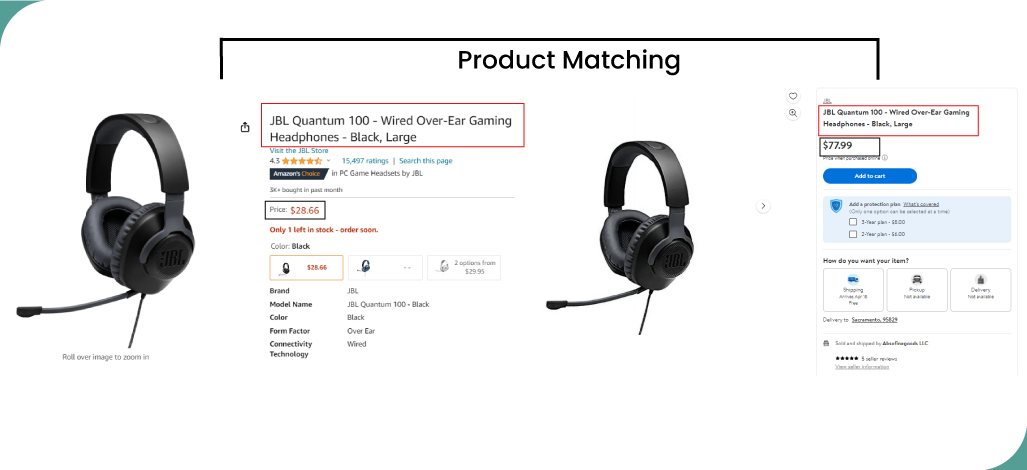The Role of Product Matching in E-Commerce in Enhancing Sales and Strategic Planning

Product matching emerges as indispensable in today's dynamic e-commerce environment, characterized by cutthroat competition and ever-evolving consumer expectations. Product data scraping facilitates the identification of similar items across multiple platforms, enabling companies to optimize sales, refine marketing strategies, and enhance overall customer satisfaction. This blog explores the transformative potential of matching product data, highlighting its efficacy in driving revenue growth, streamlining marketing efforts, and enriching the shopping experience for consumers. By leveraging advanced e-commerce data scraping services, businesses can gain valuable insights into market trends, competitor activities, and consumer preferences, thereby gaining a competitive edge in the fiercely competitive e-commerce landscape.
About Product Matching
Product matching involves comparing various attributes of products, such as their names, descriptions, images, and specifications, to determine whether they are identical or similar. This process is crucial for spotting trends, analyzing competitors, and making informed product pricing and marketing strategy decisions. Whether conducted manually or through automated tools and algorithms, product matching aims to ensure the accuracy, currency, and relevance of data.
For instance, a retailer may list its products on its website and external platforms like Amazon. Maintaining consistency in product appearance across all platforms using e-commerce data scraping aids customer comprehension and simplifies inventory management. This uniformity eliminates consumer confusion and enables the retailer to monitor stock levels effectively. Consequently, when customers encounter a product advertised on one platform and subsequently find it on another, they can readily recognize it. Consistent product presentation instills confidence in buyers, whether browsing the retailer's website or purchasing elsewhere. Moreover, it facilitates efficient inventory management for the retailer.
Importance of Product Matching in E-commerce

Product matching is a crucial aspect of e-commerce, ensuring consistency, relevance, and trustworthiness in product listings across various platforms. By scraping e-commerce product data, businesses can enhance customers' shopping experiences and streamline operations behind the scenes.
Consistent Shopping Experience:
- Product matching ensures that customers encounter the same product regardless of where they search or what description they provide.
- Consistent product listings across platforms create a seamless purchasing experience, instilling confidence and fostering customer loyalty.
Improved Search Relevancy:
- Effective product matching enhances search results by including relevant goods, increasing the likelihood of customers finding what they're looking for.
- It boosts customer satisfaction and leads to higher conversion rates, as users can quickly discover products that meet their needs.
Personalized Recommendations:
- Product matching enables businesses to tailor recommendations to individual customers by analyzing product similarities.
- This personalized approach enhances the relevance of suggestions, encouraging customers to explore more options and make additional purchases.
Reduced Customer Confusion:
- Consistent product listings can lead to clarity and satisfaction among customers.
- Product matching minimizes confusion by consistently displaying the same or similar items, reducing the chances of customers abandoning their purchase journey due to uncertainty.
Smooth Collaboration:
- Behind the scenes, product matching promotes better communication and collaboration between retailers and suppliers.
- Standardized formats and data-sharing protocols streamline the exchange of product information, reducing errors and delays and ensuring a smoother experience for businesses and customers.
Trustworthy Information:
- Trust is paramount in online shopping, and product matching helps build trust by providing accurate and consistent product information.
- Customers can rely on matched and verified data, eliminating the need to cross-check information from different sources and ensuring a hassle-free shopping experience.
Exploring Product Matching Methods

Exploring the realm of product matching methods unveils diverse approaches tailored for efficacy in eCommerce. Each method, from rule-based algorithms to machine learning techniques, offers distinct advantages in enhancing accuracy and transparency.
Rule-Based Matching: Transparency and Control
Employing a rule-based matching approach involves defining algorithms and rules to identify matches in eCommerce. This method uses an e-commerce data scraper to offer transparency and control, allowing users to adjust rules to meet specific requirements. The flexibility of this approach enables fine-tuning for accurate results, ensuring relevance and fairness in matching. Clear guidelines enhance understanding and trust in the matching process, making it easier to ascertain the appropriateness of matches.
Machine Learning Techniques: Learning from Data
Machine learning techniques in product matching involve training neural networks with known matches and non-matches to classify new cases. While effective, ML models can sometimes produce opaque decisions, challenging the comprehension of matching rationale. Issues like biased training data can lead to unreliable outcomes, particularly in sensitive domains. Continuous refinement of ML models is crucial to improving reliability and adaptability across diverse contexts, addressing limitations such as unfamiliar scenarios.
Integration of ML and Rules: Enhancing Accuracy and Clarity
Combining machine learning and rule-based methods offers a comprehensive solution to product matching challenges. This blended approach leverages the clarity of rules while harnessing ML's ability to decipher complex patterns. Rules provide structured guidelines, ensuring organizational coherence and predictability. Meanwhile, ML models contribute intelligence by uncovering subtle correlations and enhancing accuracy without sacrificing transparency. The synergy between these methods maximizes matching effectiveness in eCommerce environments.
Models of Product Matching in E-Commerce: Exploring Different Approaches

E-commerce product matching models utilize algorithms, data formats, and user feedback to ensure accurate, relevant listings and enhance customer satisfaction.
- Title Similarity: This approach evaluates product titles' similarity to determine matches. Despite potential differences in wording across vendors, technology facilitates the identification of identical or closely related products. By employing specific models tailored to title analysis, e-commerce platforms can effectively group similar items for buyers' convenience.
- Price Comparison: Comparing product prices serves as a critical indicator of similarity. Products with similar attributes often fall within a comparable price range, allowing buyers to gauge the relative value of different offerings. Additionally, variations in pricing can signal differences in features or quality, aiding in the differentiation of products and informing purchasing decisions.
- Image Similarity: Image comparison is vital in identifying related products based on visual similarities. Algorithms quantify the likeness between product images, even accounting for factors like lighting and angle variations. However, challenges arise when images need more labeling or visual discrepancies occur, requiring advanced image recognition technologies for accurate matching.
- Attribute Extraction: This model focuses on comparing specific attributes of products, such as size, color, brand, and model. By quantifying the differences between attributes, technology helps determine the degree of similarity between products. Products with minimal attribute discrepancies are considered identical or closely related, enabling more precise matching for buyers seeking specific features or characteristics.
Approaches to Enhance Product Matching Effectiveness
Navigating the complexities of e-commerce requires strategic approaches to ensure accurate and efficient product matching. Here, we explore effective strategies tailored for optimal matching outcomes.
Maintain Consistency: Consistency in product information dissemination across various platforms is crucial for effective matching. Just as a story maintains consistent character names, ensuring uniformity in product names, descriptions, and details prevents confusion and facilitates accurate comparisons for customers and algorithms.
Utilize Product IDs: Implementing unique identifiers for each product, akin to student or passport IDs, streamlines the tracking and matching process. These IDs serve as distinct tags, enabling precise identification, organization, and retrieval of products, thereby minimizing errors and enhancing efficiency.
Semantic Analysis: Employing advanced semantic analysis techniques, such as natural language processing, allows for a nuanced comparison of product descriptions. By recognizing semantic similarities, even amidst lexical variations like "blue jeans" and "denim pants," algorithms can accurately match products, ensuring a more precise and efficient matching process.
Error Correction: Regular review and correction of product information is essential to maintain data accuracy. Similar to proofreading an essay, identifying and rectifying errors or omissions in product details ensures the integrity of the database. This meticulous approach minimizes discrepancies, enhances reliability, and fosters customer trust in the matching process.
Collaborative Efforts: Collaboration with other companies fosters a collective approach to product matching. By sharing product data and insights, businesses can access a broader range of products and improve matching accuracy. This collaborative effort harnesses synergies, leveraging combined resources and expertise to enhance the overall quality and effectiveness of product matching in the e-commerce landscape.
Conclusion
Efficient product matching in e-commerce significantly influences sales, marketing strategies, and customer satisfaction, ensuring online shoppers find what they seek without confusion. Businesses offering consistent, accurate, relevant product listings enhance the shopping experience, fostering customer engagement and loyalty. Partnering with expert services enables companies to optimize their product matching processes, driving increased sales and maintaining a competitive edge in the online marketplace. Behind the scenes, businesses employ sophisticated algorithms, standardized data formats, and user feedback mechanisms to continuously refine and improve their product matching strategies, enhancing all stakeholders' overall online shopping experience.
Leverage the power of data-driven decisions with Retail Scrape Company. Gain valuable insights into consumer behavior, optimize pricing strategies, and surpass competitors using real-time retail data scraping. Elevate your business with comprehensive pricing optimization and strategic decision support services. Connect with us today to revolutionize your retail operations and maximize profitability!
